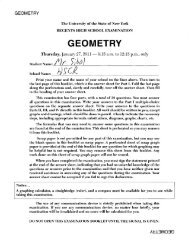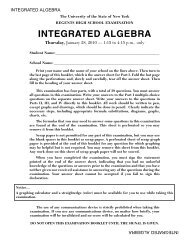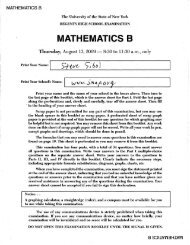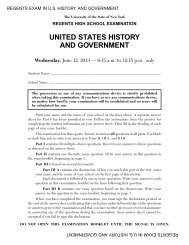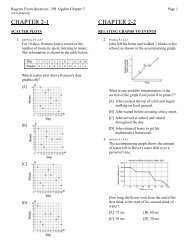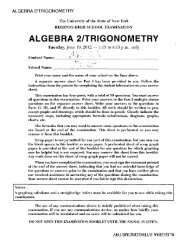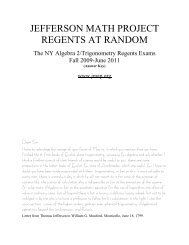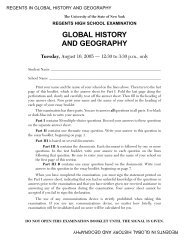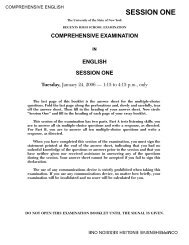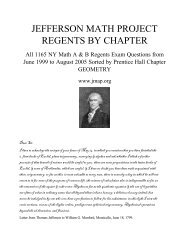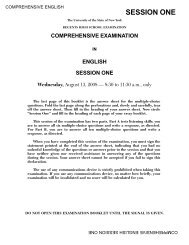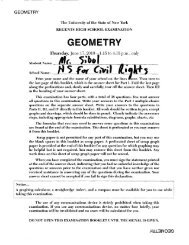SESSION ONE - JMap
SESSION ONE - JMap
SESSION ONE - JMap
Create successful ePaper yourself
Turn your PDF publications into a flip-book with our unique Google optimized e-Paper software.
QUALITY<br />
6<br />
Responses at this<br />
level:<br />
<strong>SESSION</strong> <strong>ONE</strong> – PART A – SCORING RUBRIC<br />
LISTENING AND WRITING FOR INFORMATION AND UNDERSTANDING<br />
5<br />
Responses at this<br />
level:<br />
4<br />
Responses at this<br />
level:<br />
3<br />
Responses at this<br />
level:<br />
2<br />
Responses at this<br />
level:<br />
Meaning: the extent to<br />
which the response<br />
exhibits sound<br />
understanding,<br />
interpretation, and<br />
analysis of the task<br />
and text(s)<br />
-reveal an in-depth<br />
analysis of the text<br />
-make insightful<br />
connections between<br />
information and ideas in<br />
the text and the assigned<br />
task<br />
-convey a thorough<br />
understanding of the text<br />
-make clear and explicit<br />
connections between<br />
information and ideas in<br />
the text and the assigned<br />
task<br />
- convey a basic<br />
understanding of the text<br />
-make implicit<br />
connections between<br />
information and ideas in<br />
the text and the assigned<br />
task<br />
-convey a basic<br />
understanding of the text<br />
-make few or superficial<br />
connections between<br />
information and ideas in<br />
the text and the assigned<br />
task<br />
-convey a confused or<br />
inaccurate understanding<br />
of the text<br />
-allude to the text but<br />
make unclear or<br />
unwarranted<br />
connections to the<br />
assigned task<br />
Development: the<br />
extent to which ideas<br />
are elaborated using<br />
specific and relevant<br />
evidence from the<br />
text(s)<br />
-develop ideas clearly<br />
and fully, making<br />
effective use of a wide<br />
range of relevant and<br />
specific details from the<br />
text<br />
-develop ideas clearly<br />
and consistently, using<br />
relevant and specific<br />
details from the text<br />
-develop some ideas<br />
more fully than others,<br />
using specific and<br />
relevant details from the<br />
text<br />
-develop ideas briefly,<br />
using some details from<br />
the text<br />
-are incomplete or<br />
largely undeveloped,<br />
hinting at ideas, but<br />
references to the text are<br />
vague, irrelevant,<br />
repetitive, or unjustified<br />
Organization: the<br />
extent to which the<br />
response exhibits<br />
direction, shape, and<br />
coherence<br />
-maintain a clear and<br />
appropriate focus<br />
-exhibit a logical and<br />
coherent structure<br />
through skillful use of<br />
appropriate devices and<br />
transitions<br />
-maintain a clear and<br />
appropriate focus<br />
-exhibit a logical<br />
sequence of ideas<br />
through use of<br />
appropriate devices and<br />
transitions<br />
-maintain a clear and<br />
appropriate focus<br />
-exhibit a logical<br />
sequence of ideas but<br />
may lack internal<br />
consistency<br />
-establish, but fail to<br />
maintain, an appropriate<br />
focus<br />
- exhibit a rudimentary<br />
structure but may<br />
include some<br />
inconsistencies or<br />
irrelevancies<br />
-lack an appropriate<br />
focus but suggest some<br />
organization, or suggest<br />
a focus but lack<br />
organization<br />
Language Use: the<br />
extent to which the<br />
response reveals an<br />
awareness of audience<br />
and purpose through<br />
effective use of words,<br />
sentence structure,<br />
and sentence variety<br />
-are stylistically<br />
sophisticated, using<br />
language that is precise<br />
and engaging, with a<br />
notable sense of voice<br />
and awareness of<br />
audience and purpose<br />
-vary structure and<br />
length of sentences to<br />
enhance meaning<br />
-use language that is<br />
fluent and original, with<br />
evident awareness of<br />
audience and purpose<br />
-vary structure and<br />
length of sentences to<br />
control rhythm and<br />
pacing<br />
-use appropriate<br />
language, with some<br />
awareness of audience<br />
and purpose<br />
-occasionally make<br />
effective use of sentence<br />
structure or length<br />
-rely on basic<br />
vocabulary, with little<br />
awareness of audience<br />
or purpose<br />
-exhibit some attempt to<br />
vary sentence structure<br />
or length for effect, but<br />
with uneven success<br />
-use language that is<br />
imprecise or unsuitable<br />
for the audience or<br />
purpose<br />
-reveal little awareness<br />
of how to use sentences<br />
to achieve an effect<br />
Conventions: the<br />
extent to which the<br />
response exhibits<br />
conventional spelling,<br />
punctuation,<br />
paragraphing,<br />
capitalization,<br />
grammar, and usage<br />
-demonstrate control of<br />
the conventions with<br />
essentially no errors,<br />
even with sophisticated<br />
language<br />
-demonstrate control of<br />
the conventions,<br />
exhibiting occasional<br />
errors only when using<br />
sophisticated language<br />
-demonstrate partial<br />
control, exhibiting<br />
occasional errors that do<br />
not hinder<br />
comprehension<br />
-demonstrate emerging<br />
control, exhibiting<br />
occasional errors that<br />
hinder comprehension<br />
-demonstrate a lack of<br />
control, exhibiting<br />
frequent errors that make<br />
comprehension difficult<br />
• If the student writes only a personal response and makes no reference to the text(s), the response can be scored no higher than a 1.<br />
• Responses totally unrelated to the topic, illegible, incoherent, or blank should be given a 0.<br />
• A response totally copied from the text(s) with no original student writing should be scored a 0.<br />
1<br />
Responses at this<br />
level:<br />
-provide minimal or no<br />
evidence of textual<br />
understanding<br />
-make no connections<br />
between information in<br />
the text and the assigned<br />
task<br />
-are minimal, with no<br />
evidence of development<br />
-show no focus or<br />
organization<br />
-are minimal<br />
-use language that is<br />
incoherent or<br />
inappropriate<br />
-are minimal, making<br />
assessment of<br />
conventions unreliable<br />
- may be illegible or not<br />
recognizable as English<br />
[3]



